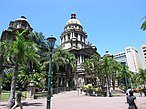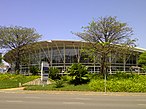Durban, KwaZulu-Natal
| Durban | ||||||||
|---|---|---|---|---|---|---|---|---|
Clockwise from top left: Durban CBD, Ushaka Marine World, Suncoast Casino and Entertainment World, Moses Mabhida Stadium, Inkosi Albert Luthuli International Convention Centre and Durban City Hall.
|
||||||||
|
||||||||
|
|
||||||||
| Coordinates: 29°53′S 31°03′E / 29.883°S 31.050°ECoordinates: 29°53′S 31°03′E / 29.883°S 31.050°E | ||||||||
| Country | South Africa | |||||||
| Province | KwaZulu-Natal | |||||||
| Municipality | eThekwini | |||||||
| Established | 1880 | |||||||
| Government | ||||||||
| • Mayor | Zandile Gumede (ANC) | |||||||
| Area | ||||||||
| • City | 225.91 km2 (87.22 sq mi) | |||||||
| • Metro | 2,292 km2 (885 sq mi) | |||||||
| Population (2011) | ||||||||
| • City | 595,061 | |||||||
| • Density | 2,600/km2 (6,800/sq mi) | |||||||
| • Metro | 3,442,361 | |||||||
| • Metro density | 1,500/km2 (3,900/sq mi) | |||||||
| Racial makeup (2011) | ||||||||
| • Black African | 51.1% | |||||||
| • Coloured | 8.6% | |||||||
| • Indian/Asian | 24.0% | |||||||
| • White | 15.3% | |||||||
| • Other | 0.9% | |||||||
| First languages (2011) | ||||||||
| • English | 49.8% | |||||||
| • Zulu | 33.1% | |||||||
| • Xhosa | 5.9% | |||||||
| • Afrikaans | 3.6% | |||||||
| • Other | 7.6% | |||||||
| Postal code (street) | 4001 | |||||||
| PO box | 4000 | |||||||
| Area code | 031 | |||||||
| GDP | US$ 63.9 billion | |||||||
| GDP per capita | US$ 15,575 | |||||||
| Website | www |
|||||||
Durban (Zulu: eThekwini, from itheku meaning "bay/lagoon") is the largest city in the South African province of KwaZulu-Natal. Durban's metropolitan municipality ranks third among the most populous urban areas in South Africa after Johannesburg and Cape Town. It is also the second most important manufacturing hub in South Africa after Johannesburg. It forms part of the eThekwini Metropolitan Municipality. Durban is famous for being the busiest port in South Africa. It is also seen as one of the major centres of tourism because of the city's warm subtropical climate and extensive beaches. The municipality, which includes neighbouring towns, has a population of almost 3.5 million, making the combined municipality one of the biggest cities on the Indian Ocean coast of the African continent. It is the largest city in KwaZulu-Natal which is the 2nd most populous province in South Africa. It has the highest number of dollar millionaires added per year of any South African city with the number rising 200 per cent between 2000 and 2014. In May 2015, Durban was officially recognised as one of the New7Wonders Cities together with Vigan, Doha, La Paz, Havana, Beirut, and Kuala Lumpur.
Archaeological evidence from the Drakensberg mountains suggests that the Durban area has been inhabited by communities of hunter-gatherers since 100,000 BC. These people lived throughout the area of present-day KwaZulu-Natal until the expansion of Bantu farmers and pastoralists from the north saw their gradual displacement, incorporation or extermination. Little is known of the history of the first residents, as there is no written history of the area until it was sighted by Portuguese explorer Vasco da Gama, who sailed parallel to the KwaZulu-Natal coast at Christmastide in 1497 while searching for a route from Europe to India. He named the area "Natal", or Christmas in Portuguese.
...
Wikipedia












